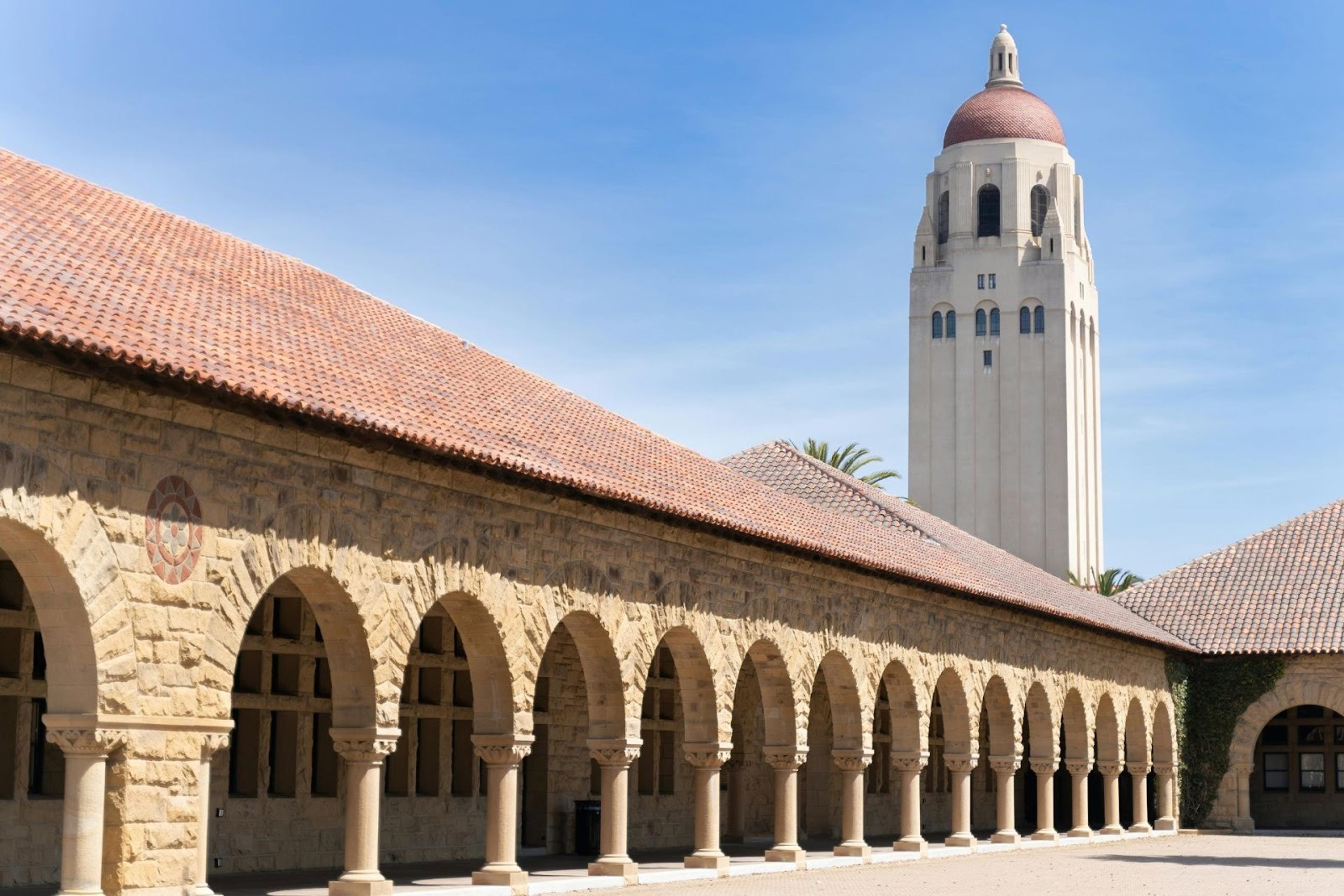Stanford MSCS: Program Overview, Acceptance Rate, & How to Get In
Curious about the Stanford MSCS acceptance rate? Learn how competitive it really is and what top applicants do to stand out and get in.
Posted November 6, 2025

Join a free event
Learn from top coaches and industry experts in live, interactive sessions you can join for free.
Table of Contents
If you’re aiming for a master’s program in computer science and Stanford is on your radar, this guide is your blueprint, not just for understanding the program, but for competing at the level it demands. We’ll break down what makes Stanford’s MSCS unique, how selective it really is, and what the strongest applicants do differently to rise above the rest.
From curriculum structure and specialization paths to admissions criteria, file strategy, and insider tips from admitted students, this is both a high-level overview and a tactical game plan to help you build a focused, high-impact application.
What is the Stanford MSCS program?
The program formally described as a degree in computer science (the MS in Computer Science) at Stanford offers a full‑time graduate pathway where students build advanced expertise in computer systems, algorithms, artificial intelligence (AI), human–computer interaction (HCI), network security, data science, software engineering, and more.
Key features:
- Students enroll in a broad base of computer science courses and guided electives (more on those later) that allow them to dive deep into one or more areas (such as network security, artificial intelligence, and human-computer interaction).
- The program emphasizes both rigorous theory and applied systems work, so you’ll learn core theory, but you’ll also complete projects, collaborations, and possibly work that ties into research or industry applications of computer, algorithmic, and system design.
- By choosing electives and special tracks, you can steer your focus toward, e.g., software engineering, data science, HCI, or network security.
- While the program is not identical to a PhD in research focus, it is offered by a leading engineering and computer science department at a top‑tier university, meaning that research and collaboration opportunities do exist, but they may be more optional or self‑driven than in a pure research MS track. (For example, several students on forums note that paid RAships are rare for MS students).
Curriculum snapshot:
- The MS program typically requires 45–50 units (varies) of approved coursework. Core foundations in algorithms, systems, data science, computer theory, and software engineering. Then, a range of elective courses where you select specialized topics like machine learning/AI, network security, human-computer interaction, data mining, and more.
- You’ll likely collaborate with faculty or other students, participate in research labs or systems projects, and gain exposure to real‑world applications (especially via the university’s proximity to Silicon Valley).
- Because you’re at Stanford, networking, collaboration, and research‑adjacent work are built into the environment: you’ll learn from leading faculty, cross‑collaborate with other departments, and leverage the engineering ecosystem.
Stanford MSCS Acceptance Rate & How Competitive Admission Really Is
Stanford does not officially publish an acceptance rate for its MS in Computer Science program, but multiple sources point to extremely high selectivity. Unlike the PhD track, where funding and research alignment are primary filters, the MS program evaluates a broader pool of academically strong applicants, and competition is fierce.
On Reddit and GradCafe, students report that even candidates with near-perfect GPAs, research experience, and top-tier internships are frequently rejected. One Redditor estimated an acceptance rate "under 5%" based on patterns in public decision threads, writing:
"Look at who gets in. They’re students who graduated top of their class, often with research or industry experience."
Similarly, GradCafe admissions result compilations show dozens of highly qualified applicants getting turned away, reinforcing just how selective the program is. Stanford doesn’t provide cutoffs, but that’s the point: the bar is both high and holistic.
Given Stanford’s elite standing and the prestige of its computer science department, it’s safe to infer that the MSCS program has one of the lowest acceptance rates among U.S. master’s programs in engineering and CS.
What this means for you as an applicant:
If you’re applying, assume this is a reach school, even if you’ve done everything “right.” One student on College Confidential put it bluntly:
“Admissions to Stanford are hard to predict. It’s a reach for nearly everyone.”
To be a serious contender, your application needs to go far beyond high test scores or a good transcript. You’ll need a clearly defined focus (e.g., AI, network security, software engineering), compelling projects or research, and a story that communicates why you’re pursuing this degree now and why Stanford is the right fit.
And don’t assume this is easier to get into just because it’s an MS. This is Stanford. The criteria are rigorous, and the applicant pool is full of brilliant, deeply motivated students from around the world. Treat it accordingly.
Admissions Criteria: What The Computer Science Program Is Looking For
Here are the major criteria you’ll be evaluated on when applying to the Stanford MSCS program. Use this checklist to audit your profile and application.
| Criterion | What they’re looking for | Tactical tip |
|---|---|---|
| Academic preparation in computer science & math | Strong undergrad in CS or related field; core courses in algorithms, systems, theory | Highlight your CS major, GPA, key courses in your transcript; if a non‑CS background, show compelling motive and bridging coursework. |
| Relevant software engineering, systems, or research experience | Evidence you can handle advanced CS coursework & collaborate in labs or teams | Showcase internships, project work, open source contributions, publications (if any), especially in AI, network security, HCI, or systems. |
| Clear purpose & specialization (e.g., AI, HCI, data science, network security) | They want students who are intentional: not just “CS generalist” but you’ll bring something specific | In your statement, pick 1–2 areas (e.g., artificial intelligence, network security, human-computer interaction) and show how past work leads to future direction. |
| Strong letters & personal statement | Recommenders who know you well, a statement of purpose that explains why this program at this university, your goals, and how you will contribute | Ask professors or managers who can speak specifically on your CS work; your statement should include a clear purpose, previous CS/engineering work, and future impact. |
| Fit with department research/systems ecosystem | Even though this is an MS, having familiarity with faculty work, labs, or university strengths helps | Review faculty publications in your interest area (AI, algorithms, systems, network security) and mention concrete ways you will engage. |
| Ability to handle full‑time rigor in a top engineering environment | The program expects high performance; you’ll be part of an engineering community. | Highlight leadership or collaboration in projects, a resilient mindset, the ability to learn quickly, and teamwork experience. |
From applicant forums:
“When I was doing the grad school search… a lot of the students in the master’s program… had some work or research experience.”
Exec your profile like you’re applying for a top CS full‑time program, not just any generic MS.
6 Strategic Application Steps: How to Get Into Stanford’s MSCS
The Stanford MSCS application isn’t just about submitting documents; it’s about constructing a story that makes you impossible to ignore. Here’s how to approach it like a top-tier applicant.
Step 1 - Decide Your Specialization and Shape Your Story
Start by identifying one or two focus areas within computer science that genuinely align with your background and goals, whether that’s artificial intelligence, network security, human-computer interaction, data science, or software engineering. Your chosen specialization should drive every element of your application.
In your statement of purpose, clearly explain why you’re pursuing graduate study now, why Stanford specifically, and how your past experience, from research to internships to independent projects, connects to your future trajectory.
Show that your direction isn’t generic or exploratory, but focused and intentional. Admissions committees want to know how you’ll contribute to the Stanford CS community through systems research, algorithmic work, security engineering, HCI studies, or beyond.
Read: Statement of Purpose vs. Personal Statement: Differences, Tips, & What to Know
Step 2 - Build a Transcript and Project Portfolio That Signals Readiness
Stanford expects academic excellence, but more importantly, it wants students who can apply that knowledge in real-world or research contexts. Your transcript should reflect strong performance in core computer science and math courses: algorithms, data structures, systems theory, discrete math, and beyond. But grades alone won’t differentiate you. You need tangible work (software you’ve built, systems you’ve designed, vulnerabilities you’ve patched, data you’ve analyzed, interfaces you’ve tested).
Highlight these projects in your resume and statement, and if possible, include a research component or publication. Stanford doesn’t require research for the MS, but demonstrating the ability to contribute to a research lab or collaborate with faculty on complex systems sets you apart. Most importantly, frame your academic and technical experience as a story of growth, contribution, and engineering impact.
Step 3 - Secure Letters of Recommendation That Validate Your Impact
Strong letters aren’t about prestige; they’re about specificity. Choose recommenders who have worked closely with you and can speak in detail about your technical skills, collaborative mindset, and readiness for graduate-level CS work. Ideally, two letters should come from professors in computer science or engineering, and one can be from an industry manager or mentor if relevant.
Equip your recommenders with your statement of purpose, project summaries, and transcripts so they can tailor their letters accordingly. A generic “top 5% of students” won’t stand out. A letter that speaks to your leadership in an HCI user study or your problem-solving in a network security internship will.
Read: How to Get Started on Your Letters of Recommendation for Graduate School
Step 4 - Align Your Application With the Program’s Elective Pathways
One of the strongest signals you can send in your application is that you understand and have thought deeply about how you’ll use the Stanford MSCS to specialize. Review the elective course offerings and map them to your goals.
If you’re applying with a focus on AI, mention how courses like CS 229 and CS 231N align with your research interests or industry ambitions. If your passion is systems and security, show awareness of courses like CS 255 or CS 261. Tailoring your application in this way demonstrates not just ambition but institutional fit: a trait top admissions teams prioritize.
Step 5 - Polish Your Application Package to the Highest Standard
Every piece of your application should reinforce the story you’re telling. Proofread your statement line by line: no typos, no clichés, no filler. Submit your resume, transcripts, letters, and statement with precision and care. Make sure you’ve addressed all of the department’s application guidelines, including the 8,000-character limit on the statement of purpose.
Check that your narrative aligns with the selection criteria: academic preparation, technical excellence, research or project experience, clarity of purpose, and potential to contribute to Stanford’s CS community. Apply early if you can, and keep your overall application strategy diversified. Stanford is ultra-selective, so having strong backup options is just smart.
Read: 10 Grad School Statement of Purpose Examples That Worked
Step 6 - Keep Building Even After You Hit Submit
Don’t treat submission as the finish line. Continue working on projects, publishing papers, or engaging in open-source contributions. If there’s an opportunity to reach out (respectfully) to faculty whose work aligns with your interests, especially in AI, HCI, or systems, do so. T
his kind of thoughtful networking can’t replace a weak application, but it can strengthen an already solid one. For international students, start early on visa documentation, I-20 paperwork, and financial planning. Stanford’s CS department provides guidance on these logistics through its international student services.
If you’re preparing for the upcoming admissions cycle, schedule a free 30-minute strategy session with one of Leland’s top MSCS admissions coaches:
- Sonya K. — Former Stanford admissions reader with deep expertise helping applicants craft standout applications to top computer science master’s programs.
- Ramon S. — MSCS admit to Stanford and Harvard with a systems-focused background and proven coaching results for elite STEM programs.
Why This MSCS At Stanford Is Worth It (And When It May Not Be)
Why is it worth it
A master’s degree in computer science from Stanford isn’t just a credential but also a launchpad. You're earning your education from one of the most respected engineering and computer science institutions in the world. The Stanford brand carries weight across academia, industry, and entrepreneurship, which can materially impact your access to top-tier roles and research opportunities long after graduation.
The program puts you at the center of technical innovation. Whether your focus is artificial intelligence, network security, data science, software engineering, or human-computer interaction, you’ll have access to leading faculty, cutting-edge labs, and the broader Stanford innovation ecosystem. Opportunities to collaborate with professors, engage in research, or intern at companies a few miles down the road in Silicon Valley are built into the experience.
Graduates from the MSCS program move into highly competitive technical roles, from machine learning engineers at Google to systems architects at startups to PhD students at MIT. The curriculum not only sharpens your technical skills but also expands your ability to think critically, write persuasively, and solve real-world problems: traits that translate directly into career and leadership potential.
Perhaps most importantly, the structure of the program is flexible. You can tailor your experience through specialized elective courses, whether you want to go deep into distributed systems, advanced algorithms, or emerging fields like AI safety or HCI research. That adaptability is especially valuable if you’re still exploring the full landscape of computer science and want to design a curriculum that aligns with both your interests and the market’s evolving needs.
For many students, it also becomes a foundation for long-term academic or industry leadership. The degree can serve as a stepping stone to a future PhD or fuel a career pivot, especially if you’re building on a technical undergraduate education and want to deepen your expertise or transition into more specialized work.
In short: if you're ready to operate at the highest level of the field, and you want to do it alongside some of the smartest students, researchers, and engineers in the world, Stanford delivers. Just be ready to file an application that proves you're among them.
When It May Not Be Worth It
That said, the Stanford MSCS is not the right choice for everyone, and that’s worth stating clearly. If your academic background in computer science or mathematics is weak or incomplete, you may find yourself quickly outpaced. This is not a remedial or exploratory master’s program. It’s a rigorous, full-time, high-pressure engineering environment designed for students who already have a solid foundation and are ready to accelerate.
If your primary goal is to conduct long-term research and funding is essential, this program may be less optimal than a fully funded PhD track. While some MS students do secure RA or TA roles, they are limited and highly competitive. As one applicant put it in a forum:
“Getting a paid RA-ship with popular professors is most difficult. Most of them prioritize PhDs.”
The cost is another consideration. Stanford is expensive. When you combine tuition, living expenses, and opportunity cost, the total investment is significant. If you’ve received a fully funded offer elsewhere, especially from a university with strong alignment to your goals, you’ll want to compare the ROI carefully, especially if finances are a major constraint.
Finally, the degree alone doesn’t guarantee elite outcomes. If your application is unfocused, your coursework shallow, or your project portfolio underdeveloped, you may walk away with a credential that holds less weight than it should. Stanford provides the platform, but you have to show up with the direction, initiative, and drive to maximize it. If you’re not ready to file a competitive, well-aligned application backed by strong academic and project credentials, it may be worth strengthening your profile further before applying.
Special Tracks And Focus Areas To Highlight
Here are some of the core specializations you should consider, each with strategic advice on how to present them:
- Artificial Intelligence (AI) / machine learning - Demonstrate prior project or research in ML/AI, show intent to take advanced electives, mention how you’ll apply AI (in systems, data science, industry, research).
- Network Security & Systems - If your interest is network security or systems engineering, highlight a project in vulnerability analysis, systems development, or security research; emphasize how you want to learn about secure systems, algorithms for security, and the design of resilient infrastructure.
- Human‑Computer Interaction (HCI) - If you’re drawn to design, usability, interface engineering, mention a user study or interface project; link to electives in HCI and show how your background (software engineering, design) supports this path.
- Data Science & Software Engineering - If data science or software engineering is your focus, you might build on prior internships, data pipelines, analytics, full‑stack projects, or large‑scale systems; show how you’ll use this MS to scale your role, deepen your technical systems expertise, and take on leadership in engineering.
Read: A Great Admissions Coach Can Be Life-Changing – Here’s How
Key Takeaways & Final Action Plan
- Understand that the Stanford MSCS is extremely competitive; treat it as a top engineering full‑time MS degree, not a fallback.
- Develop a strong profile: CS/math excellence, specialized project or research, leadership/engineering experience, clear purpose statement, strong letters.
- Pick your focus (AI, network security, HCI, software engineering, data science) and build your story around it.
- Review the program’s site and electives list carefully; align your application to the program and the university.
- Apply with care: polish every element, respect deadlines, and engage in any networking opportunities.
- Have backup options and perhaps a “Plan B” — applying to the program is worthwhile, but don’t place all bets without a contingency.
Final Thoughts: Turning a Competitive Dream Into a Strategic Reality
Earning a spot in Stanford’s MSCS program isn’t just about meeting the bar; it’s about clearly exceeding it, and showing that you belong in one of the most selective, high-impact computer science environments in the world. That means more than strong grades or prestigious internships. It means presenting a focused, compelling narrative backed by deep technical experience, collaborative potential, and a clear understanding of how you’ll contribute to and benefit from Stanford’s engineering ecosystem.
Ready to make your Stanford MSCS application as strong as your ambition?
Work one-on-one with a master’s program coach who’s helped applicants get into Stanford, MIT, Berkeley, and beyond. They’ll help you build a sharper narrative, strengthen your positioning, and give detailed feedback on your essays, résumé, and recommender strategy. Also, check out our free events for more insights!
See: The 10 Best Graduate & PhD Admissions Consultants: What They Do and When to Hire One
Read next:
- Georgia Tech Online Master's in Comp Sci (OMSCS) — What to Know & How to Get In (2025)
- How to Write a Personal Statement for Grad School (According to the Experts)
- How to Write a Killer Letter of Intent for Graduate School
- Beyond the Checklist: How to Showcase Your Unique Skills and Experiences in Your Grad School Applications
- What Extracurriculars are Graduate Programs Looking For?
- Why ChatGPT Can’t Write Your Personal Statement
- A Word of Caution on Application Essays and AI
- What GPA Do You Need to Get Into Graduate School?
- What Does "Holistic Review" Mean in Graduate School Admissions?
- Graduate Admissions: Myths Busted!
FAQs
What is the acceptance rate for Stanford MSCS?
- Official published numbers are not available for the MS in CS program specifically. Applicant forums suggest the rate is very low (under 5 %) for admitted students.
Do I need to have research experience to apply?
- While this is not strictly a research‑only MS, having research or strong systems/project work helps significantly. Several applicants say a lack of such experience makes admission tougher.
Can I focus on network security or HCI in this degree?
- Yes. The program allows specialization via elective courses, and your statement/purpose can address a focus in areas such as network security or human-computer interaction.
Will this degree lead directly to a PhD?
- Not automatically. The MS program is distinct from the PhD in CS at Stanford. If your goal is a PhD, you should emphasize research potential in your application.
What are the best elective courses to choose?
- That depends on your specialization. If you’re interested in AI, pick advanced AI/ML electives. For network security, select advanced systems/security electives. For HCI, choose user‑interface, human factors, and design courses. Align your electives with your story.
Browse hundreds of expert coaches
Leland coaches have helped thousands of people achieve their goals. A dedicated mentor can make all the difference.



















